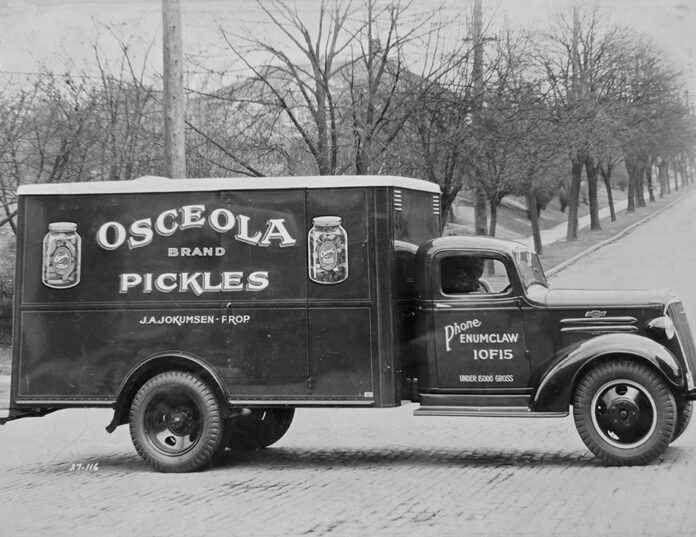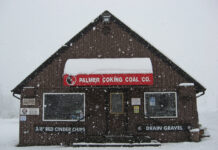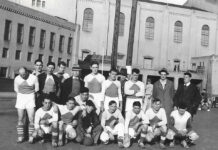Osceola, a farming area west of Enumclaw, was the subject of our last two columns that examined the community’s second and third schools, both of which still stand. This week’s focus is on Osceola’s growth and commerce. The area, located along the Auburn-Enumclaw highway, SR-164, was first settled by Allen Porter, who filed a land claim for 320 acres in 1853. He built a log cabin, planted oats and potatoes, but left during the 1855-56 Indian Wars. For most of the next two decades, Porter was the only White settler on the Enumclaw Plateau.
When the Northern Pacific Railway announced Tacoma as the western terminus of its transcontinental railroad in 1873, settlers began considering the vast plateau between the Green and White Rivers, which measured 291 square miles, each section comprising 640 acres of land. Homesteaders were generally able to claim one-quarter section, or 160 acres, by inhabiting the property and putting the land to productive use. From 1873 to 1880, 27 pioneers filed claims for just over 4,000 acres.
The next decade, the 1880s, saw an explosion of new residents, some filing homestead claims, and others purchasing land from Northern Pacific Railway. Over 125 pioneer families either filed claims or purchased nearly 19,000 acres on the Enumclaw Plateau. The railroad’s land grant, authorized by Congress, entitled Northern Pacific to every odd section of land within 20 miles on either side of its line. Railroad property was often sold for $3 to $6 per acre.
Most settlers cleared their land and constructed small log cabins until profits from farming allowed them to build better homes. Pioneer families planted orchards and vegetable gardens while raising hogs, cattle, and poultry. The top cash crop that practically every Enumclaw Plateau farm planted was hops. Hops are a key ingredient in beer production, which provide the bitter taste, and act as a preservative to lengthen beer’s shelf life from a few weeks to years. The popular Indian Pale Ales were developed by English brewers during Britain’s rule of India. To make sure their casks of beer stayed fresh on long sailing trips to India, ale brewers increased the concentration of hops, hence the origin of IPAs.
Enumclaw farmers flourished on the rich plateau soils. Though harvesting hops was very labor-intensive, whole communities gathered to ensure the crop was picked. Entire families went into the fields, and even townspeople joined the trek to earn good wages. Crews typically included a high percentage of Native Americans, who were prized hop pickers, never tiring, and working through all kinds of weather. According to Trudy (Mathews) D’Armond, “Natives all the way from Yakima would make the long trek here to help with the hop harvesting, working side-by-side with farmers and families to get the job done.”
However, in the early 1890s, hop production began to decline. Hop blights caused by aphids ravaged unsprayed fields, increasing farmers’ costs. Mold and mildew in Western Washington’s damp climate also took its toll. Hop growing eventually migrated to the drier Yakima Valley, which now produces 70% of all U.S. hop production.
As hop crops faded, dairy farming became the new darling on the Enumclaw Plateau. The Enumclaw Cooperative Creamery Co. was owned by the dairy farmers who pooled their resources and co-marketed their products, primarily fresh milk, sweet cream, and butter. By 1939, the Enumclaw Creamery ran a fleet of 17 trucks and sold over two million tons of butterfat each year.
In 1929, John Alfred Jokumsen started the Osceola Pickle Company, using cucumbers raised on his own property, located at the intersection of S.E. 448th and 228th Ave. S.E. The cucumbers were brined on site in 12-foot-tall wooden vats and 3,000 wooden barrels. During the early years, J.A. Jokumsen marketed his pickles from a booth in the Pike Place Market. Using Danish recipes, Jokumsen launched a three-generation business that lasted 48 years, until the untimely 1975 death of John Jokumsen III. His wife, Jeanne Jokumsen, continued the business for another two years, but shut it down in the spring of 1977. The operation consistently moved 300 tons of products per year.
The Jokumsen farm also drew attention from archaeologists after the discovery of Native American artifacts around 1968. Under the direction of Gerald Hedlund, a Green River Community College instructor, students began digging and collecting artifacts from beneath a fast-flowing mudflow from Mount Rainier about 5,600 years ago. That lahar destroyed everything in its path, but much later created conditions for a vibrant farming community.
Hedlund believed the former Indian village or gathering site might have been a gateway to the old Naches Trail used to connect Yakima tribes to their Puget Sound brethren. Hedlund stated his students catalogued about 24,000 artifacts in total, including 13,000 made from stone tools. Today, the old Jokumsen pickle farm is owned by the Archaeological Conservancy, an Albuquerque, New Mexico, non-profit organization that identifies, acquires, and preserves significant archaeological sites in the United States.
This photo of the Jokumsen’s Osceola Brand Pickle truck was taken on a brick street in the Queen Anne area of Seattle around 1937 and comes courtesy of Jeanne Jokumsen. Research for this column was aided by Nancy Irene Hall’s “In the Shadow of the Mountain” (1983); “There Is Only One Enumclaw” (1995) by Louise Poppleton; the archives of the Enumclaw Plateau Historical Museum; and news clippings from the Enumclaw Courier-Herald, including a Jan. 27, 1977 interview with Jeanne Jokumsen and a Sept. 28, 1988 article about Jokumsen-Stobie site artifacts.







